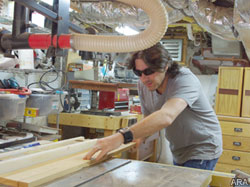(ARA) – As consumers and marketers have jumped onto the trend, it’s no longer difficult to outfit your home with products that are classified as “green.” You now have multiple choices among products that claim to be the most environmentally friendly, which can cause some confusion about which ones are the best.
“Many products are labeled green, but it’s important to know what green really means. When selecting green building materials, consider their overall impact on the environment,” says Mike McDonald, national green homebuilder. “Select products that are natural and renewable.”
Where do you start in determining which products provide the best energy savings and least environmental impact as you embark on your next home project? Begin by asking three questions.
1. Where does it come from and what has gone into producing it?
Did it come from the earth or was it produced in a factory? Usually, the less time spent manufacturing the product in a factory means less energy consumed in preparing the product for your use, as the heavy machinery required to manufacture materials in a factory setting also uses lots of energy.
Look for natural products that are renewable, growing back quickly and efficiently, and that use few or no chemicals or compounds that negatively affect the environment. Look for North American wood products that come from independently certified forests.
2. What is the product’s true overall impact on the environment?
Think about the energy that’s needed to manufacture, transport and eventually dispose of the product. Knowing where a product comes from is half the battle. When shopping for building products, ask the retailer these types of questions. Native wood products from the United States or Canada will have travelled a shorter distance when they make it to your house.
You should also give thought to the impact of any work you might need to do with the products once you bring them home from the store or lumber yard. “For home improvement projects, select materials that are durable and easy to install,” says Brian Kelsey, star of HGTV’s Creative Edge. “Avoid materials that create toxic dust when cut.”
3. How long will the material last and how will it hold up?
A key to conservation is selecting materials that will hold up for a long time, as they won’t need to be harvested or manufactured as frequently. This will save you money in the long run as well. McDonald and Kelsey recommend using wood products like Western Red Cedar for projects because it’s the most sustainable choice and it’s beautiful, durable and will outlast other choices. Naturally resistant to moisture, cedar products can last longer than alternative manmade materials like composites. Cedar can also be restored and reused in other building projects. Plus, it is biodegradable if discarded.
“I use Western Red Cedar for everything,” says Kelsey. “Beyond the beauty, the natural oils in the cedar prevent rot. So instead having to go out and buy a chemically treated pine for outdoor projects, I can use cedar and not worry about the chemicals.”
By asking the right questions, you’ll be sure that you are doing your part for the environment by selecting the building products with the least impact. Whether you are building a deck, siding your house or adding warmth to interiors, if you select the right material, you’ll ensure that your projects will look good for longer. For more information on sustainable wood products, visit www.wrcla.org.

